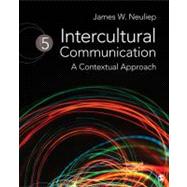
Note: Supplemental materials are not guaranteed with Rental or Used book purchases.
Purchase Benefits
What is included with this book?
| The Necessity of Intercultural Communication | |
| The Need for Intercultural Communication | |
| Human Communication | |
| Fundamental Assumptions About Intercultural Communication | |
| The Ethics of Intercultural Communication | |
| Chapter Summary | |
| Discussion Questions | |
| Key Terms | |
| References | |
| The Cultural Context | |
| IndividualismâÇôCollectivism | |
| An Intercultural Conversation: Individualistic and Collectivistic Cultures | |
| The Pancultural Self | |
| High- and Low-Context Communication | |
| An Intercultural Conversation: High- and Low-Context Cultures | |
| Value Orientations | |
| Power Distance | |
| An Intercultural Conversation: Large and Small Power Distance Cultures | |
| Uncertainty Avoidance | |
| a Theory of Uncertainty Orientation | |
| An Intercultural Conversation: Weak and Strong Uncertainty Avoidance | |
| Chapter Summary | |
| Discussion Questions | |
| Key Terms | |
| References | |
| The Microcultural Context | |
| Microcultural Group Status | |
| Muted Microcultural Groups | |
| Microcultures in the United States | |
| Chapter Summary | |
| Discussion Questions | |
| Key Terms | |
| References | |
| The Environmental Context | |
| Environments and Information Load | |
| Culture and the Natural Environment | |
| Culture and Natural Disasters | |
| The Built Environment | |
| Cross-Cultural Comparisons of Housing | |
| Privacy | |
| Monochronic Versus Polychronic Time Orientation | |
| An Intercultural Conversation: Monochronic and Polychronic Cultures | |
| Chapter Summary | |
| Discussion Questions | |
| Key Terms | |
| References | |
| The Perceptual Context | |
| Culture and Cognition | |
| Stereotyping | |
| An Intercultural Conversation: Stereotyping | |
| Ethnocentrism | |
| Chapter Summary | |
| Discussion Questions | |
| Key Terms | |
| References | |
| The Sociorelational Context | |
| Dimensions of Group Variability | |
| Role Relationships | |
| An Intercultural Conversation: Student/Teacher Role Positions | |
| An Intercultural Conversation: Cross-Cultural Role Positions | |
| Sex and Gender Roles Across Cultures | |
| Chapter Summary | |
| Discussion Questions | |
| Key Terms | |
| References | |
| The Verbal Code: Human Language | |
| The Relationship Between Language and Culture | |
| The Structure of Human Language | |
| Elaborated and Restricted Codes | |
| Cross-Cultural Communication Styles | |
| An Intercultural Conversation: Direct and Indirect Speaking | |
| An Intercultural Conversation: Personal and Contextual Speaking | |
| An Intercultural Conversation: Instrumental and Affective Speaking | |
| Language and Ethnic Identity | |
| Chapter Summary | |
| Discussion Questions | |
| Key Terms | |
| References | |
| The Nonverbal Code | |
| Definitions of Nonverbal Communication | |
| The Relationship Between Verbal and Nonverbal Codes | |
| Channels of Nonverbal Communication | |
| Nonverbal Communication and Dimensions of Cultural Variability | |
| An Intercultural Conversation: Violation of Nonverbal Expectancies | |
| Chapter Summary | |
| Discussion Questions | |
| Key Terms | |
| References | |
| Developing Intercultural Relationships | |
| Communication and Uncertainty | |
| Anxiety Uncertainty Management Theory of Effective Communication | |
| Uncertainty Reduction and Intercultural Communication Apprehension | |
| An Intercultural Conversation: Uncertainty Reduction and Sociocommunicative Style | |
| Empathy and Similarity in Relationship Development | |
| Perceptions of Relational Intimacy Across Cultures | |
| Chapter Summary | |
| Discussion Questions | |
| Key Terms | |
| References | |
| Intercultural Conflict | |
| Definition of Intercultural Conflict | |
| An Intercultural Conversation: KimâÇÖs Model of Intercultural Conflict | |
| The Concept of Face, Facework, and Communication Conflict Styl | |
| An Intercultural Conversation: Dominating and Third-Party Conflict Styles | |
| The Intercultural Conflict Style Inventory | |
| a Culture-Based Situational Model of Conflict | |
| Individualistic and Collectivistic Approaches to Conflict | |
| Conflict Resolution in High- Versus Low-Context Cultures | |
| Chapter Summary | |
| Discussion Questions | |
| Key Terms | |
| References | |
| Intercultural Communication in Organizations | |
| Intercultural Management | |
| An Intercultural Conversation: Clashing Cultural Concepts on the Job | |
| An Intercultural Conversation: Misinterpretation of Common U.S. Phrases | |
| Intercultural Relations | |
| An Intercultural Conversation: Business Communication in the Middle East | |
| Chapter Summary | |
| Discussion Questions | |
| Key Terms | |
| References | |
| Acculturation, Culture Shock, and Intercultural Competence | |
| Acculturation | |
| Culture Shock | |
| Intercultural Communication Competence | |
| a Model of Intercultural Competence | |
| An Integrated Model and Measure of Intercultural Communication Competence | |
| Chapter Summary | |
| Discussion Questions | |
| Key Terms | |
| References | |
| Table of Contents provided by Publisher. All Rights Reserved. |
The New copy of this book will include any supplemental materials advertised. Please check the title of the book to determine if it should include any access cards, study guides, lab manuals, CDs, etc.
The Used, Rental and eBook copies of this book are not guaranteed to include any supplemental materials. Typically, only the book itself is included. This is true even if the title states it includes any access cards, study guides, lab manuals, CDs, etc.